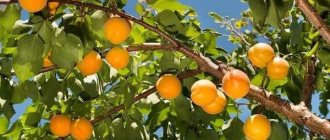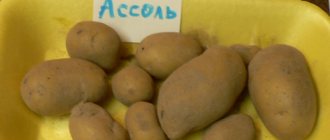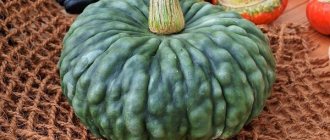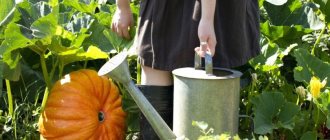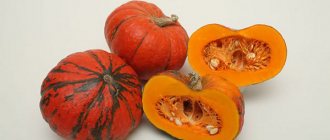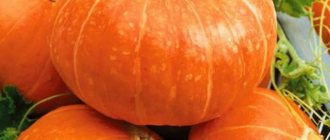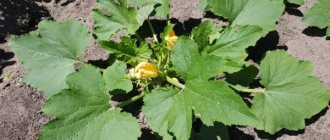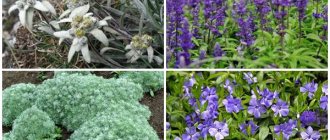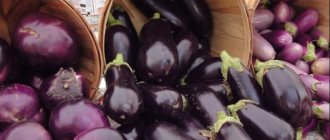Vegetable growing » Pumpkin
1
697
Article rating
Kira Stoletova
Hokkaido pumpkin is a storehouse of elements beneficial to the body. When prepared correctly, it can outshine other crops in the kitchen.
Varietal description Hokkaido pumpkins
It can be baked, steamed, added to salads, main courses, porridges, and soups. The seeds of the culture are also useful.
Features of the vegetable
Hokkaido pumpkin - in Japan, potimarron (chestnut pumpkin) - in France, "winter" - in England, Hokkaido - in Russia - this is the name of this compact, sweetish taste, eye-catching representative of melons with its bright color and unusual shape.
Mature Hokkaido is most often a small fruit (its weight can range from 800 g to 2.5 (less often 3) kg, pear-shaped or slightly flattened. There are also larger relatives of this Japanese vegetable, which are still inferior in popularity to the portioned pumpkin ( Hokkaido is sometimes called this because of its small size).
The color of this pumpkin is varied: from sunny orange and bright red to grayish or green. Because of this, questions sometimes arise as to whether the green part of the Hokkaido pumpkin is poisonous. All doubters can be confidently answered: no, it is not poisonous. Green Hokkaido pumpkin can be safely cooked and tastes just as good as orange or reddish ones. At the same time, the pulp of the vegetable will be just as tender, with a clear chestnut or nutty flavor characteristic of this particular pumpkin variety.
The Japanese vegetable is good in all respects. Thus, the undoubted advantages of the Hokkaido pumpkin - reviews of housewives and world chefs confirm this - include its rapid ripening (the growing season averages 3 to 3.5 months from the moment the seeds are sown), the ability to be stored for a long time (the pumpkin can lie in the basement or just in a cool place, safe and sound almost all winter), thin peel (when hot processed, the skin becomes very soft, so it is often eaten along with the pulp). Let's add to this a delicate taste, usually associated with sweet chestnut or potato, as well as nut or nutmeg - after all, Hokkaido refers specifically to the nutmeg varieties of this crop.
Big Moon pumpkin variety
For example, Big Moon pumpkins grow to 70–90 kg in 115–130 days, although only one ovary will have to be left on a powerful bush. The average weight of fruits suitable for drying, preparing home canned food and juices is 20–50 kg. On long vines, round or slightly flattened fruits ripen with a smooth yellow skin and juicy pulp that retains its taste well until spring.
How to grow Hokkaido pumpkin
It is worth noting that in terms of vegetation, this variety differs little from those varieties of pumpkin whose homeland is Russia: it is very unpretentious in care and can be successfully grown in a temperate climate. And in order for the beds to always be productive, it is worth listening to the advice of those who have been growing various varieties of Hokkaido pumpkins for a long time.
So, to get an earlier harvest, gardeners often resort to the seedling method of growing this Japanese delicacy. For this purpose, about a month before planting in open ground, the seeds are soaked for several hours in warm water, after which they are placed on a damp cloth and kept there until sprouts appear (this takes about 3 days). To prevent the germinating seeds from drying out, you need to constantly monitor the condition of the napkin - it should be slightly damp. You can also use a solution of potassium permanganate to wet the napkin - it will prevent the growth of bacteria and rotting of seeds. Finally, the “hatched” seeds are placed in separate pots - it is advisable that each seed settles in its own “house”, deepening them by 3-4 cm.
Caring for a pumpkin after planting tender sprouts in open ground does not cause much trouble. There are only a few rules to remember.
Since Hokkaido prefers warmth, it is advisable to plant pumpkins in warm soil and in well-sunny corners of the site. Further, in addition to loosening the soil, you only need to remember about regular watering - Hokkaido loves this - and the need to control the number of fruits on one vine. Japanese pumpkin is distinguished by its abundant fruiting, but experts recommend leaving no more than 7-8 fruits on the vine - this will help to obtain larger fruits at a relatively early date.
By the way, beginning gardeners, including those who decide to plant Hokkaido, will benefit from this advice. As you know, pumpkin vines grow greatly and therefore take up quite a lot of space. To save space on the plot, experienced people plant pumpkins in tall barrels. This, firstly, turns the pumpkin into a fairly compact plant, and secondly, it gives some originality to the design of the site.
Growing technology
Japanese Hokkaido pumpkin is a crop that requires heat and light. Place it in areas that are well lit throughout the day. For strongly climbing plants, trellises, cones or huts are installed. To grow, plantings of this variety need a lot of useful substances, which they take from the soil. Therefore, chernozems, sandy loam soils and light loams are more suitable for cultivation.
Advice! When preparing a site for growing melons per 1 sq. m add 5-6 kg of humus or manure. To better warm the soil, build a box or high ridges.
The Hokkaido variety has one of the shortest ripening periods for pumpkin crops - 95-100 days. Seeds can be planted by direct sowing into the ground. For the initial phase of growth, the sprouts are provided with shelter in the form of a small greenhouse. Seeds germinate at a temperature of +14°C. But the optimal temperature is considered to be +20...+25°C, at which sprouts appear within a week.
Even slight frosts are harmful to the plant. Therefore, in regions with cold springs, the Hokkaido variety is grown through seedlings. Sowing begins at the end of April.
Melons do not tolerate well when their root system is disturbed, so it is better to grow seedlings in peat pots. You can put 2 seeds in one container. The hole for sowing is made 5-10 cm deep. When two sprouts germinate, one seedling is left, which is stronger. A plant with 4-5 true leaves is transplanted into open ground.
Add to the hole during transplantation:
- 150 g ash;
- 100 g sawdust;
- 50 g superphosphate.
After transplantation, the plants are watered with any growth stimulant.
Pumpkin does not like dense plantings, so in open ground each plant is planted at a distance of 1 m from each other. And also away from zucchini. After setting several fruits, the main stem is pinched, leaving 4-5 leaves at the top.
Pumpkin is drought resistant due to its developed root system. It needs to be watered infrequently, but abundantly. Plantings of the Hokkaido variety are watered once a week, using 20-30 liters of water per 1 square meter. m.
Advice! As the plants grow, they are lightly covered with moist soil, weeded and loosened.
When growing pumpkin, several feedings are necessary during the growth period. Fertilizers are used in dry and liquid form. It is best to alternate organic and mineral fertilizers.
Required fertilizers:
- nitrogen - added during planting, stimulate growth, prevent wilting of the vegetative mass;
- phosphorus - added at the beginning of the formation of ovaries;
- potassium - used during flowering.
When using liquid organic fertilizers, do not allow them to get on the leaves and stems.
It is not recommended to keep the Hokkaido pumpkin on the vine and collect it as it ripens. The last fruits are harvested before frost sets in. Remove the pumpkins together with the stem, being careful not to damage the skin. This way, vegetables will last longer. The pumpkin is best kept at a temperature of +5... +15C in a dark room. When storing, it is important that Hokkaido pumpkins do not come into contact with each other. It is recommended to store Ishiki Kuri pumpkins for no longer than six months.
Varieties of Japanese pumpkin
Despite the fact that the Japanese vegetable has several varieties, two of its varieties turned out to be more popular: Ishiki Kuri Hokkaido pumpkin and Hokkaido Orange pumpkin. Both the first and second pumpkins are characterized by sweet orange flesh, bright orange skin color and pear-shaped shape. It’s just that the first variety is more rounded, and the second one is somewhat elongated.
There is one more common feature that may have ensured the high popularity of these Japanese pumpkins: the small size of the Hokkaido pumpkin (both Ishiki Kuri and Orange) allows it to be used as an “edible” pot for preparing a wide variety of dishes. After all, the heat-treated walls of this vegetable, as noted above, are no less tasty than its pulp.
Diseases and pests, how to deal with them
Pumpkin variety Ishiki Kuri Hokkaido F1 is quite resistant to most common diseases inherent in other “pumpkin” crops. Bushes can become infected with fungal diseases or be affected by aphids if plants are planted in the shade and in a wetland.
Therefore, when choosing a site, give preference to a sunny, well-ventilated place.
In order to reduce the risk of possible illnesses, it is necessary to follow the rules of crop rotation. Keep in mind that the worst predecessors for the site are pumpkins, cucumbers, and zucchini. Because they have the same ailments, which remain in the ground for more than one year.
As a preventative measure, it is recommended to use special medications that are sold in stores. They should be used according to the manufacturer's instructions.
Benefits of Japanese pumpkin
Hokkaido belongs to the nutmeg pumpkin varieties, which determined its composition and positive effect on the human body. Pumpkin pulp is rich in folic acid and iron, fiber and antioxidants, calcium and magnesium, vitamins A to E. It is no coincidence that dishes from Hokkaido are recommended to be consumed for diseases of the heart and blood vessels, kidneys and gastrointestinal disorders. Pumpkin improves immunity and actively fights viruses. It slows down the overall aging of the body, strengthens bones and tooth enamel. Pumpkin is no less famous for its antihelminthic properties, as well as its ability to restore male strength. Plus, a small amount of Hokkaido consumed daily helps fight obesity and control weight, which makes it one of the indispensable products in the diet.
It should be noted that Japanese pumpkin, like other nutmeg varieties, has a minimum of contraindications - these are, first of all, stomach diseases, problems with acid-base balance and diabetes - and can be introduced into the diet of children over one year of age, as well as pregnant women.
There are several options for eating Hokkaido: it is heat-treated or added to dishes, for example, in fresh vegetable salads, raw. Hokkaido juice is recognized as very useful, but only in moderate quantities, from which wonderful fresh juices are obtained.
General description of Matilda
Decorative varieties
The pumpkin family includes 27 species. A huge number of varieties have been bred from each.
- large-fruited
- nutmeg
- strong-willed
- table varieties
- feed
- decorative
We will describe different varieties for cultivation in different regions of Russia, taste, etc.
Harvest
Hokkaido pumpkin: photo of variety
Pumpkin is a very tasty, healthy and beautiful vegetable. You can prepare a huge number of dishes from it, to the delight of your household. But from the many existing varieties, how to choose the one that is ideal for growing in your region. And so that the taste pleases your taste buds, and the abundance of the harvest pleases your eye.
The Hokkaido variety was bred by Japanese breeders, so it is best known in Japan. By the way, the French also grow a variety of it called Potimaron.
In Russia you can only find seeds of the hybrid of the main variety - Ishiki Kuri Hokkaido F1. It is included in the Belarusian catalog of varieties, but is not noted in the achievements of domestic breeders.
The hybrid has a rich orange color. The shape resembles a pear, good yield level. The hybrid variety is recommended for use in the fall. The fruits are stored for no more than six months.
The longer the fruit is stored, the worse its taste becomes. It becomes more bland and begins to deteriorate.
Hokkaido pumpkin has large fruits with a pronounced round stalk. The inflorescences are large, there are a lot of them, with a rich yellow color. The foliage of this variety is large, heart-shaped and green.
The growing season from the appearance of the first shoots to the moment of ripening is 90 days. The plant belongs to the early ripening varieties. Hokkaido can be stored for quite a long time - about 9-10 months. At the same time, it does not lose its taste characteristics.
The Hokkaido hybrid is unpretentious to natural conditions; it tolerates drought with dignity. Ideal for warm to moderately warm regions.
Ishiki Kuri Hokkaido F1 has a high level of productivity, several fruits are set on one shoot. You can remove a dozen small pumpkins from one plant.
The seeds have average growth vigor. In the southern regions, pumpkins are planted directly in open ground in May, while in other regions pumpkins are grown in seedlings. For the fruits to fully ripen, it is necessary to stop the growth of stems; vegetables ripen in late summer - early autumn.
Harvesting must be done when the fruits are fully ripe, otherwise the taste will be bland.
Very often, Ishiki Kuri Hokkaido F1 pumpkin is grown for decorative purposes, for example, on fences. In this case, pumpkins are grown vertically; ripe orange pumpkins look very beautiful against green foliage.
Do you want to grow tasty and healthy vegetables on your plot and at the same time get excellent yields? This is entirely possible if you grow one of the following nutmeg vegetables!
- Hokkaido pumpkin. In recent years it has become very popular, and quite recently it began to be grown on the territory of the Russian Federation in the conditions of the middle zone. A special feature is the specific nutty taste, which immediately appealed to many gardeners. The advantage is increased shelf life - almost all year round it can wait in the basement for its time and will not succumb to various fungi and rot. It is used for preparing first and second courses and does not lose its taste even after 10 months of storage at a temperature of 5-7 degrees. It is often grown on balconies, as it is unpretentious to any growing conditions.
- Pumpkin Guitar. It ranks first in terms of vitamin content, which is why it is grown by many summer residents. In addition to its benefits for the body, it has many more advantages, the main one of which is increased sweetness. Sugar content up to 12%! It is used to make porridge and jam, which has a wonderful taste. It is convenient to store, since an ordinary basement satisfies all the requirements and will keep the fruit intact and safe for several months. The only negative is that it is susceptible to dry rot if there is insufficient ventilation of the room and unfavorable air humidity. But, as a rule, before dry rot occurs, the vegetable is already eaten.
- Arabatskaya. A long and extremely beautiful fruit, it is intended mainly for making porridge and jam, as it has a peculiar fruity flavor. For many years it was grown exclusively in Europe, but now it is acclimatized in Russia. Weight is no more than 5 kg, the average is 3-4 kg. Sugar content no more than 6%
- Hylea. It has a peculiar oval shape and a flat, smooth surface. The high marketability of fruits makes it one of the leaders in exports to neighboring countries. Due to its good shelf life and transportability, it can be transported over long distances and stored for several months without any changes in taste or appearance. The crust has a bit of a crunch and the flesh is extremely soft and juicy. Despite the sugar content of only 5%, it is sweet and produces up to 400 c/ha. It is planted only at an average daily temperature of 12 0C, as it requires a lot of heat.
Nutmeg vegetables do not have a lot of sugar, but are very tasty and healthy for the body. They must be included in the daily diet to prevent diseases, improve body tone and provide nutrients, macroelements and vitamins!
Matilda is a first generation pumpkin hybrid bred by Dutch breeders. In 2009 it was included in the State Russian Register.
In the register the hybrid is designated as nutmeg. It is intended for cultivation in central and southern Russia.
Matilda pumpkin produces medium-sized fruits. On average, one pumpkin weighs 3 kg.
This nutmeg hybrid has an unusual taste. Its fruits are sweetish, starchy, with a pronounced nutty aroma. When unripe, there is no unusual aftertaste.
Matilda's attractive quality is considered to be the fleshiness of pumpkins. The fruits have thick walls and a small chamber with a small number of seeds. Despite their compact size, they contain a lot of pulp.
Matilda pumpkin is a dietary product with a rich biochemical composition and low calorie content (100 g of product contains only 22 kcal). However, it is easy to get enough of pumpkin pulp.
Pumpkin is useful for vitamin deficiency and for baby food. It contains vitamins B, A, C, PP, H, K, micro- and macroelements (potassium, calcium, magnesium, sodium, iodine, zinc, etc.), polyunsaturated fatty acids.
Matilda has increased resistance to temperature changes. It can grow in open ground even in regions with extreme climates.
Matilda's characteristics make it possible to grow it in all regions of our country. The hybrid is not afraid of temperature changes and produces fruits before the first frost.
| Options | Indicators |
| Type of ground part | Thick, long-climbing stems reach a length of 5 m. The peduncle is powerful, cylindrical in shape. There are no ribs on the stems. The leaves are large, with five cuts, rich green in color with lighter spots. The powerful root system goes several meters underground. Pumpkin produces many roots near the surface. |
| Fruit | Medium sized fruits. They reach a weight of 2.5–4.5 kg. The shape of pumpkins is pear-shaped or club-shaped. The tough rind is light orange or beige in color. The flesh is bright orange. The fruits are fleshy. Inside is a small chamber with a minimal amount of seeds. Sweet, with a pronounced nutty aroma, the starchy pulp does not fall apart when cooked. |
| Ripening time | Mid-season. Pumpkins ripen 110 days after sowing the seeds. |
| Transportability | High. Pumpkin retains commercial quality during transportation. Can be stored for up to 4 months. |
| Productivity | High. Up to 8 fruits are picked from one plant. From 1 sq. m on average, 15 kg of crop is harvested. |
| Immunity | Resistance to most diseases of melons. This will reduce the need for preventive chemical treatments. |
We treat many diseases with pumpkin
This variety belongs to the muscat family and is considered one of the most useful. The pulp and peel contain many useful substances, such as folic acid, iron, calcium, magnesium, antioxidants, fiber and a group of different vitamins.
Japanese culture has the following beneficial properties:
- Thanks to such a rich composition, Hokkaido pumpkin is recommended for diseases of the cardiovascular system, gastrointestinal tract, and kidneys;
- this vegetable helps improve immunity, it fights viruses well;
- Thanks to the calcium in its composition, pumpkin strengthens bones and tooth enamel, slows down the aging process in the body;
- it is used for helminthic infestations and intoxication;
- the fruits remove excess water from the body, they are consumed for obesity, so the variety can often be found in various dietary menus;
- There is one more useful property - the vegetable restores male strength well.
Features of Hokkaido cooking
Hokkaido pulp is dense, which allows it to be used for preparing not only porridges and casseroles, but also soups or pie fillings. It is also an excellent side dish for meat and any fatty dishes, since the unique composition of the vegetable helps to absorb heavy food more quickly. Japanese pumpkin is also excellent for freezing, as it does not lose its shape during further processing.
Housewives and chefs all over the world use Hokkaido pumpkin in their kitchens. In the recipes you can find the most unusual combination of products: pumpkin and ginger, pumpkin and chili peppers, pumpkin and citrus fruits... But what is most striking is the abundance of a wide variety of dishes: from the banal Hokkaido bake with sugar and butter to vegetable risotto and aromatic muffins. Here are just a few common pumpkin recipes and tips.
Harvesting and application
Hokkaido ripens well at room temperature, so you can remove the vegetable from the garden at the stage of incomplete maturity. Pumpkins ripen in September. They slowly fill with the desired color, keeping pace with each other. After collection, it is recommended to store Hokkaido in a dry cellar or basement.
The variety's pulp is dense, so it is used not only for making soups and casseroles, but also as a filling for pies and porridges. Pumpkin is also suitable as a side dish for fatty meat or poultry, as its beneficial properties help avoid heaviness in the stomach and promote faster digestion. The vegetable tolerates freezing well, maintaining its value and taste.
Hokkaido makes excellent puree soup. Both baked and fresh pumpkin are suitable for this. Garlic, ginger, sesame, and cream go well with this dish. Plus, this soup is often served with salmon or shrimp.
Interesting ! In Japan, Hokkaido is especially appreciated for its small size. Vegetables are convenient to use as a base for Japanese stuffed dishes. The walls of the pumpkin are no less tasty than its pulp.
Soups from Hokkaido
Pumpkin makes wonderful puree soups. Both boiled and pre-baked pumpkin in the oven are equally suitable for their preparation. Here's one option.
Bake the pumpkin until golden brown. Fry the chopped onion, chopped ginger and garlic in vegetable oil. Pour the pumpkin and fried vegetables with vegetable or meat broth, add finely chopped chili pepper to taste and boil the soup base for 20-25 minutes. Then grind the future soup with a blender to a puree and return to the fire. At this stage, the soup should be salted and flavored with your favorite seasonings. If desired, you can add lemon juice to the finished dish. Fresh herbs or a few pre-roasted sesame seeds will help serve the soup, as well as a little cream, which will give the creamy structure of the soup a special tenderness. A good option is to serve this soup with meatballs or vegetables, shrimp or salmon.
What are the benefits of this vegetable?
The Hokkaid pumpkin variety has great benefits for the whole body. Therefore, try to include pumpkin dishes in your daily diet more often. Especially if there are children and pregnant women in your home. Due to the fact that pumpkin is a real natural treasure trove of nutrients, it helps:
- Support the body in the fight against viruses,
- Strengthen immunity,
- Cope with toxicosis, gastrointestinal problems,
- Heal nerves and heart.
On a note! This pumpkin variety is known for its anthelmintic properties.
Hokkaido pumpkin dishes
What healthy dishes can be prepared from pumpkin? First of all, let's try to make pumpkin soup.
Pumpkin soup.
Exquisite cream soup adorns the menu of more than one restaurant. What is good about this soup is that there is a basis for the recipe, and you can add, remove, replace ingredients to your liking, taking into account the available products and the wishes of the family.
If you are a vegetarian, then remove the meat broth and add water. For satiety, sauté vegetables, and simmer for lightness. To add usefulness, we use olive oil, etc. Everything is very simple.
To prepare the soup, you can use both boiled and baked pumpkin.
For example:
- In heated vegetable oil, sauté onions, carrots, ginger root, garlic until golden brown and intoxicating smell.
- Add the pumpkin pre-baked in the oven and fill it all with meat broth.
- Bring to a boil and simmer over low heat for 20 minutes.
- Then beat all the vegetables into a homogeneous, tender mass, use the broth to adjust the desired thickness, add salt and pepper.
- Add your favorite seasonings, lemon juice, balsamic vinegar, and cream to taste.
On a note! When serving, you can garnish with herbs or sesame seeds.
You can also diversify your breakfast by adding pumpkin to your daily porridge. And again, complete improvisation.
Porridge can be dairy or not, made from rice, buckwheat, corn or oatmeal.
You can use either prepared (baked or boiled) pumpkin or grated raw pumpkin. It is also recommended to add it to pancakes to increase the nutritional value of the dish and enrich the diet with fiber. This breakfast just calls for honey, nuts, cinnamon, and dried fruits. For those who like to start the morning with fresh juice and freshly squeezed juice, you should also pay attention to the vitamin pumpkin.
Let's sum it up
Don’t be afraid to experiment, add pumpkin to salads, desserts, add it to the menu as a side dish, use it for filling manti, dumplings, pies, pies. Bake cupcakes and cookies with it. Prepare casseroles and simply bake it in portions in the oven. And, of course, at least once in your life, cook a whole pumpkin in the oven.
Hokkaido's small size should definitely be used to serve the dish in portions. The filling can be absolutely anything. You can combine pumpkin with meat, minced meat, fish, cottage cheese, and use various seasonings and sauces. Thanks to its compact size, the pumpkin will be completely baked, and the nutty aroma characteristic of Japanese varieties will give the dish an exquisite charm. And, of course, your guests will remember the original presentation for a long time and maybe pumpkin will become your signature dish.
Hokkaido as part of main courses
The simplest and most famous recipe in this category is milk porridge with pumpkin. To prepare it, the Hokkaido pulp is cut into cubes or grated on a coarse grater, then mixed with cereal (rice, millet, oatmeal, corn or semolina are suitable) and poured with milk. Next - everything that the cook’s imagination allows: you can, for example, add dried fruits, nuts, apples, butter. Sugar will completely replace honey, and cinnamon will add a special taste and aroma.
Pumpkin porridge can be boiled in a regular saucepan or baked in the oven - depending on your preference. So, you can pre-bake the pumpkin, pour boiling water over the cereal and leave for 10 minutes to swell. Then place the pumpkin and cereal in layers in a baking dish, pour milk over everything - it should cover the top layer by a couple of centimeters. Drizzle honey or sprinkle sugar on top. Pieces of butter will not be superfluous - it will give the porridge a special taste and aroma. Now you can cover the pan with foil and put it in the oven. In about an hour, a delicious and nutritious dish for breakfast or dinner that both adults and children will enjoy will be ready.
Vegetarians will love pilaf with pumpkin, apple and quince. For pasta lovers - spaghetti with ham, pumpkin and cream sauce, generously sprinkled with cheese and herbs. Meat or vegetable manti and cutlets, to which Hokkaido pulp is added, will definitely satisfy the taste of any gourmet.
Hokkaido pumpkin variety. Advantages and disadvantages
This variety, like its other relatives, contains a great variety of vitamins, microelements and beneficial amino acids. An excellent product for people on a diet and maintaining a healthy, proper diet.
The fruits of Ishiki Kuri Hokkaido F1 are eaten raw, and also together with the peel - this is considered to be the uniqueness of the species.
A variety of dishes can be prepared from pumpkin fruits. There are many recipes with Hokkaido pumpkin in cookbooks. For example, you can fry it like potatoes; bake, prepare cream soups. Very often, pumpkin fruits are used as pots for stuffing various desserts and other dishes.
I would like to draw your attention to the fact that the taste and aroma of the fruits of the Ishiki Kuri Hokkaido F1 variety is specific and does not resemble the characteristic taste qualities of other varieties of pumpkins.
Stuffed pumpkin
Since Hokkaido pumpkin (the photos confirm this) resembles a small pot, it is ideal for stuffing. Here is one such recipe.
Cut off the cap from a washed and dried pumpkin. Through the cut in the upper part, remove the pulp, which is cut into cubes. Fry the peeled walnuts (in a frying pan or in the oven), mix with chopped pumpkin pulp and grated cheese. Fill the pumpkins with the resulting filling. Cover Hokkaido with lids and place on a baking sheet with water poured into it. Bake for 40-45 minutes.
Another option is for meat eaters. Saute finely chopped onion, half a chili pepper and your favorite seasonings, such as rosemary, for 10 minutes. Then add finely chopped pork to the pan, season with salt and nutmeg. After another 15 minutes, add tomato puree - to do this, grate a couple of tomatoes - and simmer for another 5 minutes. Rub the inside of the prepared pumpkins with butter, put the filling in them and bake for about half an hour at a temperature of 180-200 degrees. As a side dish for these pumpkin pots, mashed potatoes are suitable, although the pumpkin itself can easily replace the side dish.
Butternut squash Pearl
Butternut pumpkins of this variety ripen in 120–130 days. The average weight of cylindrical or oval fruits formed on powerful plants reaches 3–6 kg. Pumpkins are covered with a thin orange bark, under which lies a thick, sweet, dark orange pulp containing a lot of sugar and carotene, which is beneficial for humans.
The variety shows high stable yield and good taste. Butternut squash, as in the photo, can withstand drought, but requires heat, can be used in dietary and baby food, delicious healthy juice is obtained from the fruit and low-calorie delicacies are prepared.
Desserts from Hokkaido
A traditional dessert made from this vegetable is pumpkin baked in the oven with sugar or honey and butter. Although some people prefer to bake Hokkaido slices, first pouring them with olive oil and sprinkling with salt, pepper, and spices - the result is original and non-standard.
However, it is much better to bake unusual cookies or pie from this vegetable.
Truly healthy Hokkaido pumpkin cookies are made using this recipe. Grind 200 g of pumpkin pulp to a puree and mix with 50 g of regular oatmeal, 90 g of sugar or honey, 50 ml of vegetable oil. Add salt and a teaspoon of slaked soda to the resulting homogeneous mass, then flour - as much as it takes to obtain a plastic dough. Roll out the finished dough into a thin layer and cut out cookies from it. Bake in the oven for about half an hour.
Pumpkin Pineapple F1
Externally, the fruits of this mid-season hybrid are similar to Matilda pumpkins, with the exception of a completely smooth cream-colored bark. Up to 6 pumpkins with excellent marketability and taste can ripen on the vines at the same time. Pear-shaped, weighing from 1.5 to 3 kg, nutmeg pumpkins, as in the photo, have a thin but dense peel and sweet yellow-orange pulp, with a nutmeg aroma that intensifies as it ripens.
Fruits can contain up to 10% sugar, a lot of carotene and other useful elements. This makes dishes and juices made from fruits dietary and even medicinal. The crop adapts perfectly to growing conditions, is not damaged by diseases and easily tolerates storage.
Everything without a trace
As already noted, the special advantages of Japanese pumpkin include its soft peel, which can not be cut off during the preparation of the pulp and then eaten. Don't throw away Hokkaido pumpkin seeds either. If you fry them in a frying pan or in the oven, after sprinkling them with oil and sprinkling with salt - although you can do without this - you will get a very tasty snack, rich in microelements and healthy oils. According to experts, they should be regularly included in the diet of men, since they can have a beneficial effect on potency. We must not forget about the antihelminthic properties that pumpkin seeds have to a greater extent than its pulp.
Thus, the Hokkaido pumpkin, described in this article, is a very healthy, tasty, completely unpretentious vegetable to grow, store and prepare, which should become a regular guest on the table of every person who cares about the health of themselves and their loved ones.
Volzhskaya gray pumpkin
Among the large-fruited varieties, the Volzhskaya gray pumpkin stands out for its light gray shade of skin and relatively small fruits, weighing only up to 9 kg.
The harvest from powerful vines is harvested 110–125 days after sowing. Just 2 bushes of such a pumpkin will not require much space in the beds, but the harvest will please you. Pumpkins have a flattened shape with barely noticeable segments. The bark is elastic, not thick, the pulp is extremely rich in carotene, sugars and other useful substances. The consistency is medium-dense, the pulp is very tasty and has a yellowish-cream or orange color. The variety is suitable for all types of heat treatment, drying and drying, as well as fresh consumption in juices, purees and salads.
Growing Japanese Pear Gourds
Isshiki Kari (Uchiki Kuri) and Orange Hokkaido (Oranje Hokkaido) - Japanese pear-shaped pumpkins
Gardening in personal plots is not only about obtaining fresh vegetables - it is, rather, a mass form of hobby, and for many, an art that is mastered by both rural residents and city dwellers in their dachas.
How to achieve success when growing, where to find an outlandish variety that, with unpretentiousness and simple agricultural technology, would surpass other varieties in yield and taste? People have been striving for this for years, learning the wisdom of agriculture. If you separate gardening into a separate area, then no hobby will be so widespread. Many thousands of people are constantly busy searching for an unusual variety, and its discovery is a real holiday for them.
I want to talk about two varieties of Japanese pumpkin selection
Of course, Japanese seeds are not sold in our stores. They come to us mainly through Europe or China. We are talking about unusually sweet pear-shaped pumpkins of orange color with orange pulp of the Uchiki Kuri
and
Oranje Hokkaido
(Ishiki Kari and Orange Hokkaido).
It is interesting that the Ishiki Kari variety corresponds to the name of one Japanese hieroglyph, because... resembles him in appearance. The pear shape is even more pronounced in the Hokkaido Orange variety. I tried dozens of varieties of pumpkins on my plot. There are good varieties, although they are not so common. But these two varieties amazed me. Despite the small size of the fruits - from 2 to 4 kg - they belong to the large-fruited species (Cucurbita maxima Duch), but within this species they belong to the subspecies of small-fruited, or portioned, pumpkins. The small size is convenient for eating without further worries associated with storing the cut fruit.
Over decades of testing, I have come across various Japanese pear-shaped varieties of the Hokkaido group more than once, but this was the first time I encountered the phenomenal productivity of Ishiki Kari. The summer of 2006 was unusually cold and rainy. In early June, two Ishiki Kari plants were planted in open ground at the two-week seedling stage (the Hokkaido Orange variety was grown in a different area to avoid cross-pollination).
The soil is ordinary, rich in humus, the place is open and sunny. I didn’t do any pinching or pinching when growing, I just weeded the weeds. There was no need to water, because... the summer turned out to be rainy. In mid-August, 32 fruits weighing from 2 to 4 kg were collected from two plants at once. The remaining flowers and ovaries were left for fruiting. In September, before the frost, another 17 fruits were collected; after the first frost, the growing season stopped.
To obtain seeds and preserve the purity of the variety, I did not grow other varieties of large-fruited pumpkins on the plot (Stofuntovaya, Titan, Goliath, etc.). The seeds of large-fruited pumpkins are glossy, large, matte or white - you need to know these signs when planting pumpkin seeds of unfamiliar varieties, so as not to plant pumpkins of the same type next to each other if you want to take seeds from them (two more types of pumpkins are widespread in our country: hardbark and nutmeg).
In August, after the harvest of Ishiki Kari and Orange Hokkaido, they were immediately tasted. The undoubted advantage of these varieties is the complete suitability of freshly picked fruits for consumption. The sweet, carrot-like, dense flesh up to 5 cm thick is good in salads raw, but when fried in butter or breadcrumbs with a crust, it becomes very tender and reminds some of the taste of roasted chestnuts, and others of hazelnuts. These varieties are good in all respects: early ripening (fruits ripen in 90-95 days), cold-resistant, disease-resistant, very productive.
The fruits are small, sweet, with a subtle pleasant aroma, and are stored until spring. Try growing these pumpkins too. I'll send you the seeds.
I also send seeds of tomatoes, peppers, eggplants, pumpkins, and also seeds of all kinds of vegetable, spicy, and ornamental crops; seedlings of frost-resistant varieties of grapes, apple trees, pears, cherries, sweet cherries and other crops. Send an envelope with a return address: 140080, Moscow region, Zhukovsky, PO Box 135. Sincerely, Yuri Valentinovich.
In the pictures: harvest of Japanese pear-shaped pumpkins; pumpkins of Japanese selection Ishiki Kari and Orange Hokkaido.
Yuri Petrov, experienced gardener, photo by the author
Pumpkin varieties of the Yokohama group - “fruit Japanese”
There is a whole group of traditional Japanese pumpkins called "Yokohama". The pumpkin got its name from the large port city of Japan, which was the first to be open to foreigners. At that time, the United States immediately appreciated the economic benefits of the spread of oriental vegetable wonders. And the seeds of amazing Japanese pumpkins came to the United States, where the plants underwent further breeding work.
Pumpkin variety of the Yokohama group. Lyudmila SvetlitskayaThus, in particular, the famous variety “Chirimen” was created, which seemed to us the most unusual representative of Japanese pumpkins, thanks to the unique gray coating on the peel. Due to this feature, the bluish fruits look as if sprinkled with ash.
Other notable varieties of the Yokohama group: Kogiku, Hidemi, Kikuza, Futsu Korokawa. All Japanese pumpkins are united by strong ribbing, a rough surface, a flattened shape and a small size, which makes them look like toys.
Using pumpkins in cooking
The main advantage of the fruit is its incomparable aroma, which is often called “floral”, although, in fact, it combines the sweetish smells of various tropical fruits.
It is worth noting that miniature “Japanese” are probably more suitable for the southern regions, since in our country they did not reveal the full range of taste, although we enjoyed eating them baked or could easily enjoy them raw.
The taste of pumpkins is pleasant and slightly nutty, the flesh is dense and moist, the seed chamber is small. In my garden, I annually plant several varieties of these little ones, which I use primarily as decoration.
Pumpkin variety "Chirimen". Lyudmila Svetlitskaya
Features of growing pumpkin varieties of the Yokohama group
If you want to get a rich harvest of Yokohama pumpkin, keep in mind that most of these varieties are late, and to get a well-ripened harvest, it is best to grow the plant through seedlings.
In our conditions, the fruits of this group set quite late - in the month of August, so these pumpkins work best in those years when there is a long, warm autumn, although ripening indoors is also quite possible. And around the New Year, the fruits acquire a delicate beige-orange color.
Japanese varieties are resistant to powdery mildew and other diseases.
Read the continuation of the list of the most beautiful and delicious varieties of pumpkin on the next page.

